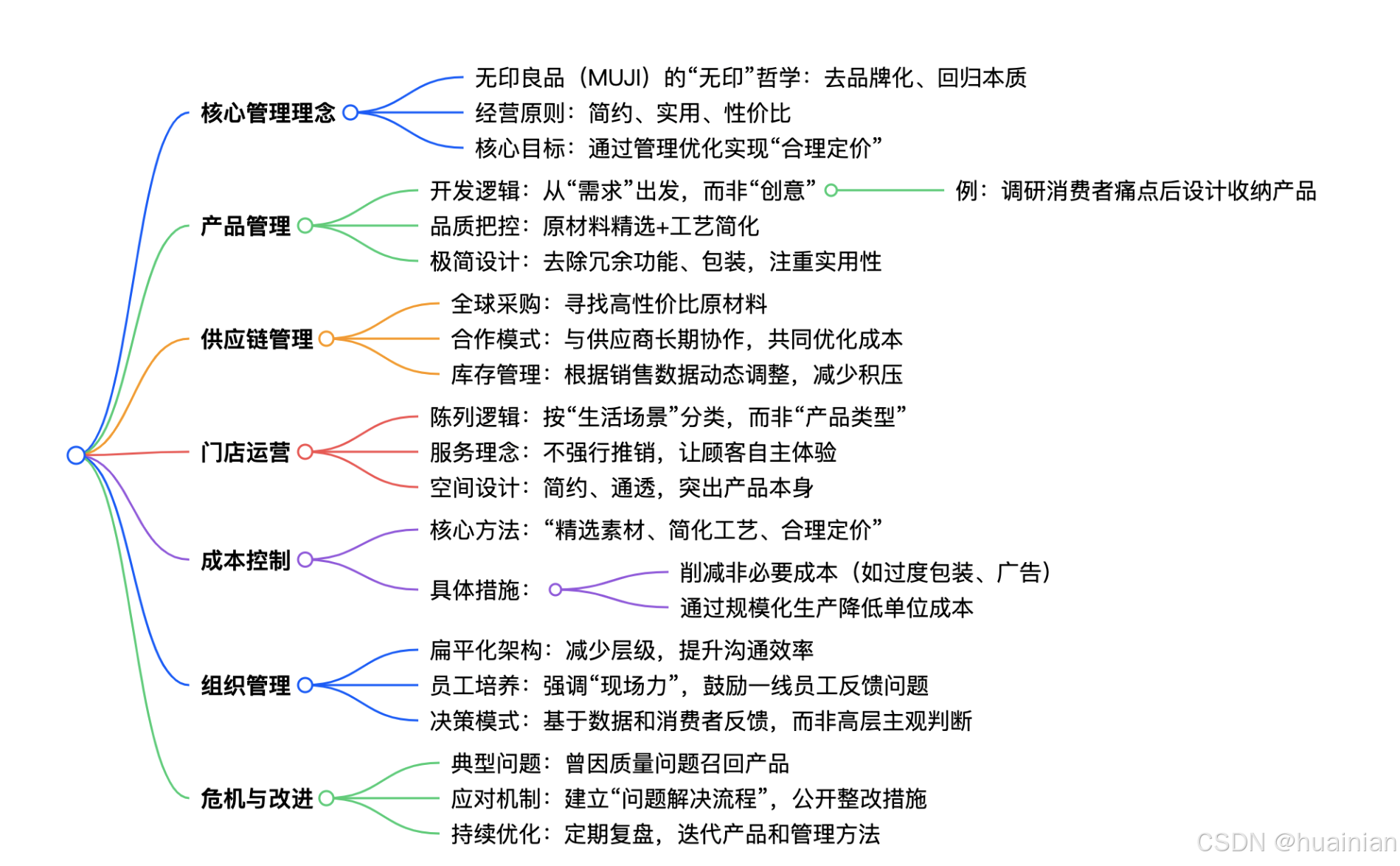一、底层管理哲学 First, the underlying management philosophy
核心思想:「无印」即「无品牌标识」,回归产品本质Core idea: "Muji" means "no brand logo", returning to the essence of products.
- 拒绝过度营销,靠产品价值打动用户 Refuse excessive marketing and impress users with product value.
- 例:包装仅标注必要信息,无多余logo For example: The packaging only marks the necessary information, without any redundant logos.
经营原点:「为生活解决问题」而非「创造需求」Business origin: "Solve problems for life" rather than "Create demand
- 调研方法:走访用户家庭,记录真实使用痛点(如收纳死角)Research methods: Visit users' homes and record real pain points in use (such as storage dead corners)
价值观:「合理就好」—— 不追求极致低价,而是“品质与价格的平衡”Values: "What's reasonable is fine" - Instead of pursuing rock - bottom prices, we aim for "a balance between quality and price".
二、产品开发与管理 II. Product Development and Management
开发流程:「观察→提案→验证→量产」四步闭环Development process: A four-step closed loop of "Observation → Proposal → Verification → Mass production
- 观察:派员工卧底竞品门店、菜市场,记录消费者抱怨Observation: Send employees to infiltrate competitor stores and wet markets to record consumer complaints
- 提案:跨部门(设计+采购+销售)脑暴解决方案Proposal: Cross - departmental (Design + Procurement + Sales) brainstorming for solutions
- 验证:制作样品后在门店试销,收集顾客试用反馈Verification: After making samples, conduct trial sales in stores and collect customer feedback on trial use.
- 量产:根据试销数据调整规格(如减少某款杯子的容量)Mass production: Adjust specifications according to test marketing data (such as reducing the capacity of a certain type of cup)
产品标准:「三不原则」 Product Standard: "Three No Principles
- 不使用不必要的材料(如保温杯去除多余装饰)Do not use unnecessary materials (such as removing excessive decorations from thermos cups)
- 不采用复杂工艺(如T恤简化缝线工序) Do not adopt complex processes (such as simplifying the sewing process of T-shirts)
- 不做华而不实的设计(如手机壳仅保留防摔功能)Don't make flashy and impractical designs (for example, the mobile phone case only retains the anti-drop function)
迭代机制:每年淘汰30%滞销品,补充20%新品Iteration mechanism: Eliminate 30% of slow-moving products and replenish 20% of new products every year.
- 数据依据:门店销售排名+用户差评关键词分析Data basis: Store sales ranking + Keyword analysis of user negative reviews
三、供应链与成本控制 III. Supply Chain and Cost Control
全球供应链布局:「哪里性价比高,就从哪里采购」Global supply chain layout: "Purchase from wherever offers the best cost - effectiveness.
- 案例:棉花从印度采购(质优价平),拉链从日本采购(耐用)Case: Cotton is sourced from India (high quality and reasonable price), and zippers are sourced from Japan (durable).
供应商管理:「伙伴关系」而非「甲乙方」 Supplier Management: "Partnership" rather than "Client - Supplier Relationship
- 共同研发:派技术人员驻厂,协助供应商改进工艺Joint R & D: Assign technicians to the factory to assist suppliers in improving the process
- 成本共担:原材料涨价时,与供应商协商分摊比例Cost sharing: When raw material prices increase, negotiate the sharing ratio with suppliers.
库存控制:「Just In Time(准时制)」模式Inventory control: "Just In Time" model
- 数据工具:用POS系统实时追踪销售,自动触发补货Data tools: Use the POS system to track sales in real time and automatically trigger replenishment.
- 处理滞销:设立「折扣区」集中清库存,避免浪费Handling slow - moving products: Set up a "Discount Area" to centrally clear inventory and avoid waste
成本压缩技巧: Cost compression techniques:
- 包装:用再生纸、无印刷塑料袋 Packaging: Use recycled paper and unprinted plastic bags
- 物流:合并同区域订单,减少运输频次 Logistics: Combine orders in the same region to reduce the frequency of transportation
四、门店运营与用户体验 IV. Store Operations and User Experience
陈列逻辑:「生活场景化」而非「品类堆砌」Display logic: "Life scene-based" rather than "category stacking
- 案例:卧室区同时摆放床品、台灯、收纳盒,模拟真实卧室Case: In the bedroom area, bedding, table lamps, and storage boxes are placed simultaneously to simulate a real bedroom.
动线设计:「无引导式」布局 Moving line design: "Non-guided" layout
- 入口无导购拦截,让顾客自由逛览 There is no shopping guide intercepting at the entrance, allowing customers to browse freely.
- 货架高度统一(1.5米),确保视线通透 The shelf height is unified (1.5 meters) to ensure unobstructed sightlines.
服务准则:「适度干预」 Service criteria: "Moderate intervention
- 顾客提问才上前,不推销“会员”“满减” Only approach customers when they have questions. Do not promote "memberships" or "discounts for reaching a certain amount".
- 试用品充足(如香薰可开盖闻,衣服可直接试穿)
门店数字化:
- 用APP记录用户浏览轨迹,优化陈列
- 自助结账占比超60%,减少排队
五、组织与人才管理 V. Organization and Talent Management
架构:「扁平化」三级体系 Architecture: "Flat" three - level system
- 总部(决策)→区域经理(协调)→门店(执行),无中间层级Headquarters (Decision - making) → Regional Manager (Coordinating) → Store (Execution), with no intermediate levels
- 好处:一线问题24小时内直达总部 Benefits: Frontline issues can reach the headquarters within 24 hours.
员工培养:「现场力至上」 Employee Training: "On-site Capability First
- 新人必轮岗3个月(采购+门店+仓库),了解全流程Newcomers must rotate positions for 3 months (purchasing + store + warehouse) to understand the whole process.
- 鼓励员工提改进建议,被采纳者获“改善奖”(如调整货架角度)Encourage employees to put forward improvement suggestions, and those whose suggestions are adopted will receive the "Improvement Award" (such as adjusting the angle of the shelves).
考核标准:「用户满意度」优先于「销售额」Assessment criteria: "Customer satisfaction" takes precedence over "Sales volume
- 定期电话回访顾客,差评由店长亲自跟进整改Regularly conduct telephone follow - up with customers. The store manager will personally follow up and rectify negative reviews.
六、危机应对与持续进化 VI. Crisis Response and Continuous Evolution
典型危机案例:2017年“甲醛超标”事件 Typical crisis case: the "formaldehyde exceeding standard" incident in 2017
应对步骤: Response steps:
- 24小时内公开召回涉事产品 Publicly recall the products involved within 24 hours
- 成立第三方检测小组彻查原因 Establish a third-party inspection team to thoroughly investigate the causes.
- 在门店张贴整改报告,透明化处理过程 Post the rectification report in the store to make the handling process transparent.
自我革新机制:「MUJI会议」 Self-innovation mechanism: "MUJI Meeting
- 每月跨部门复盘会,用数据暴露问题(如“某款笔退货率高”)Monthly cross - departmental review meeting, expose problems with data (such as "the return rate of a certain pen is high")
- 每年发布《MUJI报告》,公开经营问题及改进方案Release the "MUJI Report" every year, disclosing operational issues and improvement plans.
创新方向:从“卖产品”到“卖生活方式” Innovation direction: From "selling products" to "selling a lifestyle
- 延伸业务:MUJIcom(便利店)、MUJI INFILL(家装服务)
